Project Estimation
How to do project estimation the right way? What are the best project estimation techniques? What is the role of cost estimation in project management? – you will find detailed answers to these and many other questions about project cost estimation in this detailed guide. Whether you are a college student studying project cost management or you are a team leader at a software outsourcing company, this guide is a must-read for absolutely everyone who is curious about project management and its application in various fields.
Estimating is an inseparable part of project management services which have a financial component. Most likely, you had to deal with estimating and cost management at least once in your life (your family member’s birthday party is included). Most likely, you’ve been puzzled as to how to predict costs accurately.
Estimating is real science and trying to do any calculations without beforehand knowledge of estimation techniques and key principles is a bad idea. For this reason, we have created this guide so that everyone can learn basic principles, tips, and methods of successful estimating. So, sit back, relax, and let’s begin.
So, What Is Project Estimation?
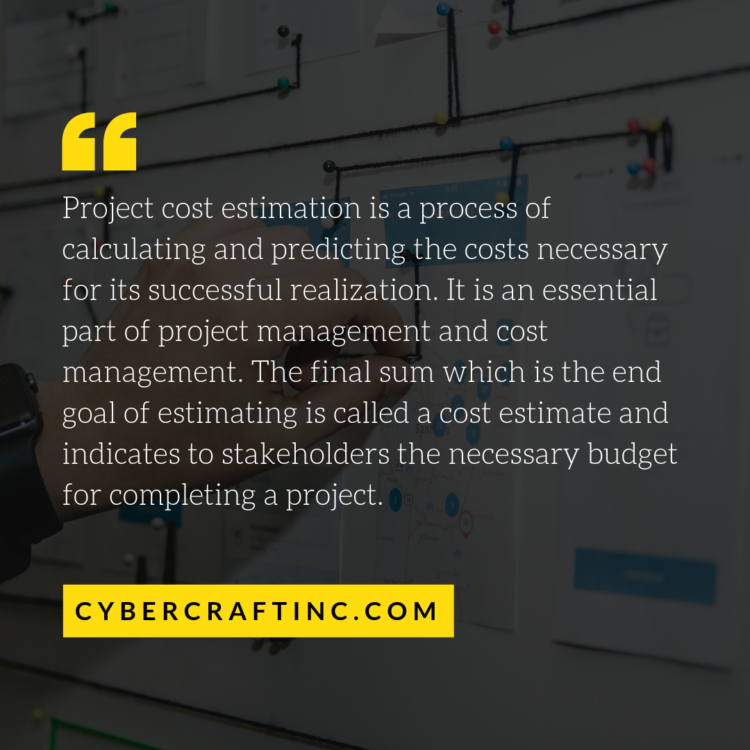
Project cost estimation is a process of calculating and predicting the costs necessary for its successful realization. It is an essential part of project management and cost management. The final sum which is the end goal of estimating is called a cost estimate and indicates to stakeholders the necessary budget for completing a project.
A budget is a key variable in project cost management which affects major processes of managing it, its components and ultimately its fate. There are two ways in which an estimate and budget affect a project’s fate:
- A project can be realized only if the given estimate does not exceed the available budget. If it does, the party which orders a project’s completion won’t be able to implement it unless it finds additional financing.
- The actual costs incurred during completion can’t exceed the provided budget. Otherwise, the stakeholders responsible for implementation will run out of funds and the project will stop (and perhaps never be realized).
Typically, besides actual sums, an estimate breaks down all work to be done into specific work sequences and tasks, indicates and explains the resources needed, provides a timeline and duration information with deadlines, and provides specific rates besides containing much more important information. Having understood the definition of a project estimate, some people, nevertheless, might still question its necessity.
To Estimate or Not to Estimate: That Is the Question
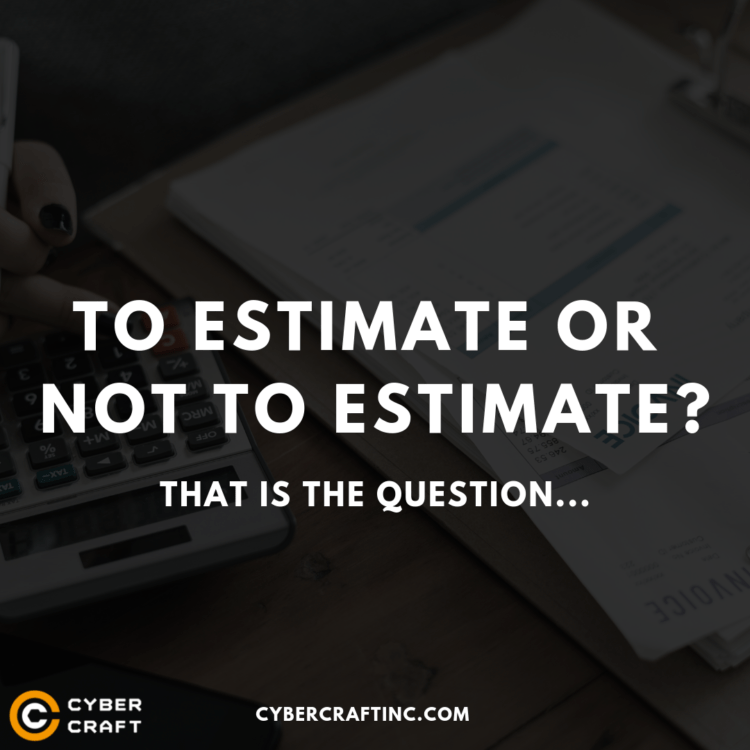
Some might wonder whether it is necessary to make calculations at all. After all, why not just begin work without them and then see how it goes, right? Furthermore, many estimates later prove inaccurate, so what’s the point of estimating if your calculations prove incorrect later on anyway? While these two objections might seem reasonable they are totally incorrect.
Let’s begin with the first one – why not just operate without an estimate? As we have already explained, if an estimate exceeds the available budget then no further work can be completed unless additional funding is obtained. If you begin work not knowing whether the available funds are sufficient you may find yourself in a situation when you run out of the budget while the work is only halfway done. There you go, no goals achieved, and no money left. Nothing is left. You don’t want to find yourself in that position.
Some readers might object: “What makes you think that the actual expenditures incurred will not exceed initial calculations and we won’t find ourselves in the situation you have just described?” That is a good question. That is the question. How do you ensure that calculations are accurate? This is the question you must be asking, not whether to estimate or not to estimate. By all means, do. But remember that your estimate is valuable as long as it is accurate. Therefore, the right question is: how to estimate a project accurately? And this question we will answer below in this guide.
The 5 Most Popular Project Management Estimation Techniques
You don’t need to come up with a methodology for cost estimation yourself (although in some rare cases it might be a good idea). The field of cost management has a vast collection of different methods for estimating expenditures. We are going to present the 5 most popular of them.
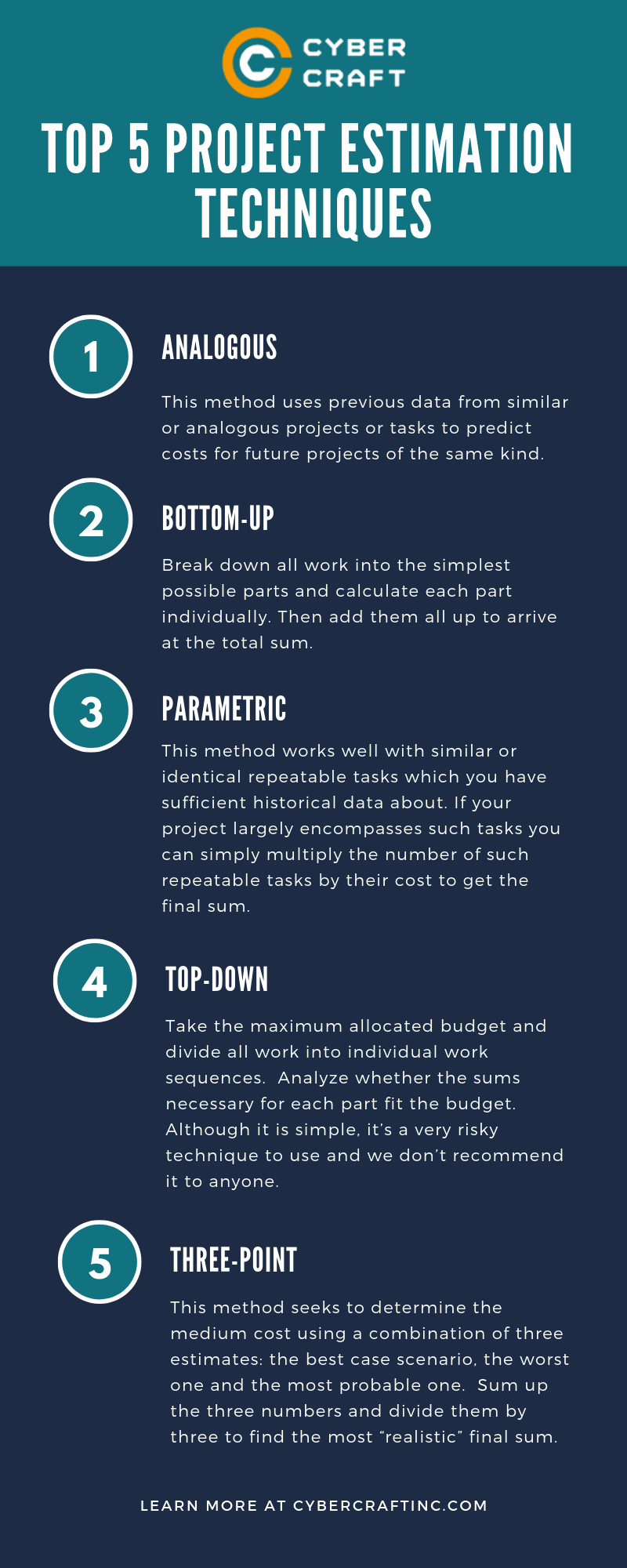
Analogous Method
This method uses previous data from similar or analogous projects. It also can be applied at a microscale by using historical data about the performance of similar or identical tasks and then building up estimates like LEGO by adding up numbers from analogous tasks.
If a new venture is similar or includes similar tasks this makes sense, logically speaking. If you are doing identical tasks, then it most likely will take as much time and require as much money. If you are doing similar work, time and expenditures should be similar. However, this, unfortunately, is not always true. Doing identical or similar tasks in another point in time and under different circumstances already implies possible deviations.
Furthermore, there are always those unexpected and unforeseen factors which can disrupt everything. Ever heard of the Black Swan? This concept perfectly applies to estimating. In a perfect world where everything stays the same, the analogous method would always prove accurate. In the real world full of chaos and randomness which creates unpredictability this method can’t be deemed 100% accurate.
Bottom-Up Method
This method is somewhat similar to Waterfall methodology in software development. You break down all work into the simplest possible parts and calculate each part individually. Then you add them all up to arrive at the total sum. More detalization provides more accuracy. It is also a good idea to apply the analogous method to increase the accuracy of estimating the cost of individual parts.
There are two possibilities which can make calculations with this method incorrect. First, if managers fail to include all the required elements in their estimation they may end up with unforeseen expenditures which result from additional tasks which were not accounted for in a cost plan. Secondly, it does not matter how detailed the calculations are if individual variables themselves are inaccurate.
Parametric Estimation
This method works well with similar or identical repeatable tasks which you have sufficient historical data about. If your project largely encompasses such tasks you can simply multiply the number of such repeatable tasks by their cost to get the final sum. This method is simple and usually accurate since you use reliable historical data for tasks which are similar or identical, i.e. there is not much randomness and unpredictability so the calculations are usually quite accurate.
Consequently, it is not a good idea to use parametric estimation for work of a different nature i.e. creative or complex processes with a low degree of predictability. In such a case, this method will be of little use.
Top-Down Estimation
We must warn you right away – it’s a not a good idea to use this one. This method is an inverse of bottom-up estimation as the name suggests. What you do is you take the maximum allocated budget and divide all work into individual work sequences. You then analyze whether the sums necessary for each part fit the budget. Although it is simple, it’s a very risky technique to use and we don’t recommend it to anyone.
Three-Point Method
This method seeks to determine the medium cost using a combination of three estimates: the best case scenario, the worst one and the most probable one. What you do is you sum up the three numbers and divide them by three to find the most “realistic” final sum. This methodology is good for reducing risk by integrating a margin of safety and considering various possibilities.
The only question is how accurate the final number is. What if the worst-case scenario occurs? Then the real cost will differ from the initial sum. These possibilities must be taken into account when using this technique. Having reviewed the most popular estimation methodologies, it would be also necessary to learn the key principles and tips for accurate estimating.

How to Estimate a Project Accurately: Top Tips
There are many things to pay attention to during project cost estimation. We are going to present the most important tips you must learn to make the final number as accurate as possible.
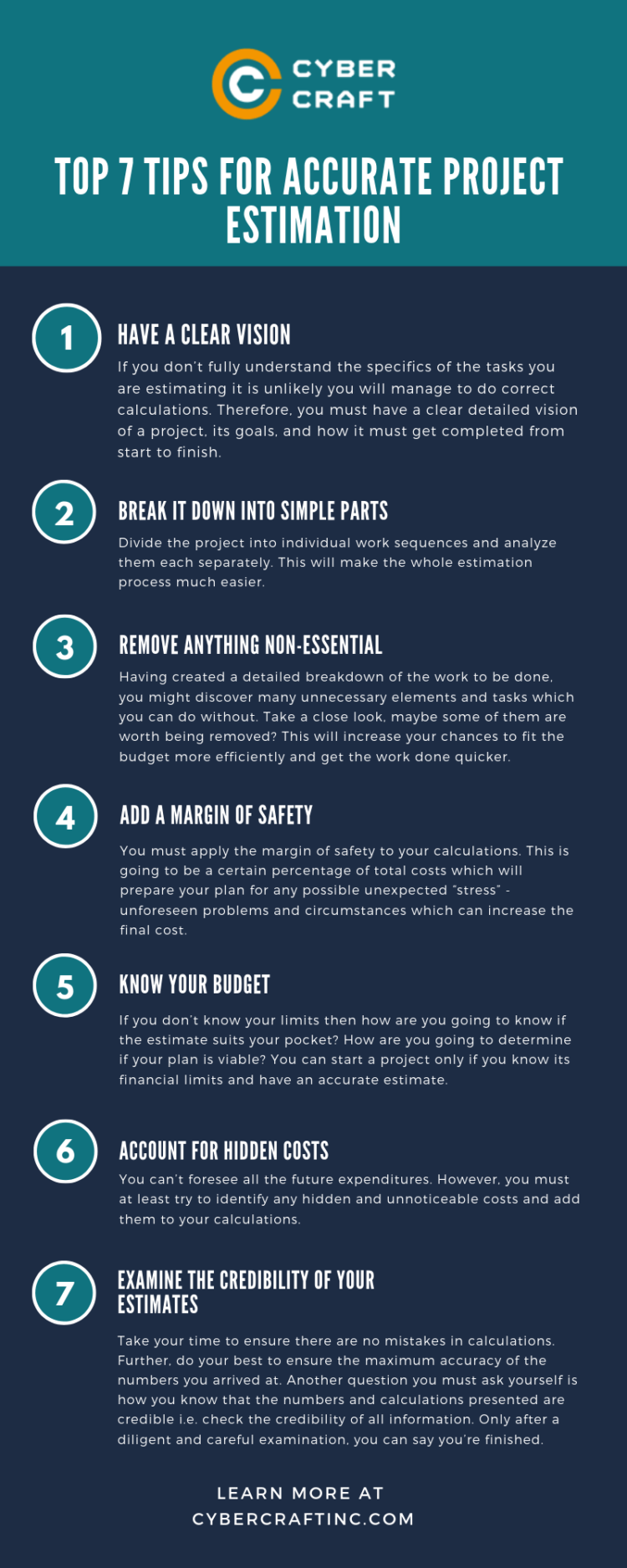
Have a Clear Vision
First, you need to know exactly what you are doing. If you don’t fully understand specifics of the tasks you are estimating it is unlikely you will manage to do correct calculations to include in your project cost management plan. Therefore, you must have a clear detailed vision of a project, its goals, and how it must get completed from start to finish. Without it, no further steps can be taken. This is the very first thing you must do to be able to proceed to the next steps.
Break It Down into Simple Parts
The most difficult tasks are easily solved when being broken down into the most fundamental parts. Similarly, even the most complex tasks in the world can be easily estimated if you break them down into smaller “mini-projects”. Divide the project into individual work sequences and analyze them each separately. This will make the whole estimation process much easier.
Remove Anything Non-Essential
Having created a detailed breakdown of the work to be done, you might discover many unnecessary elements and tasks which you can do without. Take a close look, maybe some of them are worth being removed? This will increase your chances to fit the budget more efficiently and get the work done quicker.
Add a Margin of Safety
Ever heard of the margin of safety? Simply put, it is a certain percentage which you add to the final number to prepare a system for any unexpected stress. All engineers know about and use this concept.
For instance, bridge engineers always apply this concept when building bridges by making them strong enough to handle much bigger loads than expected. You don’t want to load 10 tonnes on a bridge which can handle 12 tonnes at most, right? You want that bridge to handle 1000 tonnes but load it only with 20 tonnes. That’s a good margin of safety.
Similarly, you must apply the margin of safety to your calculations. This is going to be a certain percentage of total costs which will prepare your plan for any possible unexpected “stress” – unforeseen problems and circumstances which can increase the final cost. For example, if your total sum is 1 million dollars, you could add a 30% safety margin which would make the final number higher by 300 thousand dollars.
The real question is how high that margin must be. Unfortunately, we can’t give you a specific percentage. Everything depends on the peculiarities of your project. We would recommend 10% as a minimum margin. In any case, ensure to include this margin into your calculations to prepare for the unexpected.
Know Your Budget
We assume you already know the maximum budget you can afford to spend and have set specific limits. If you don’t then you must determine your maximum budget before you begin estimating. Why? Because this number will serve as a benchmark against which you will compare the final estimate. You are going to compare the sum you have come up with and the maximum budget to see if you can afford to take on the project.
If you don’t know your limits then how are you going to know if the estimate suits your pocket? How are you going to determine if your plan is viable? You can start a project only if you know its financial limits and have an accurate estimate.
Account for Hidden/Unexpected Costs
Expect the unexpected. Add a margin of safety to your calculations. You can’t foresee all the future expenditures. However, you must at least try to identify any hidden and unnoticeable costs and add them to your calculations. A useful concept, in this case, is second-order thinking i.e. thinking about consequences of consequences.
Similarly, it is a good idea to think about the costs of costs. When you apply this model of thinking you might discover new expenditures which were previously not noticed by anyone. Also, you might want to try to identify any probable unexpected expenditures which you might incur. This mental exercise may also help you to accurately determine a sufficient margin of safety.
Examine the Accuracy/Credibility of Your Estimates
Once you have made detailed calculations it is necessary to re-examine them one or even two times. Take your time to ensure there are no mistakes in calculations. Further, do your best to ensure the maximum accuracy of the numbers you arrived at. Another question you must ask yourself is how you know that the numbers and calculations presented are credible i.e. check the credibility of all information. Only after a diligent and careful examination, you can say you’re finished.
Having given our professional advice on what to do, we must also warn you what not to do. In other words, what mistakes you must avoid when doing calculations.
Top 5 Project Estimation Mistakes You Must Avoid
“Errare humanum est”, says a Latin proverb which is translated as “to err is human”. People make mistakes. Common wisdom teaches that mistakes are good, we learn from them right? In cost management mistakes are not good, they are something you must avoid by all means. For this reason, we decided to highlight the most widespread and serious mistakes in estimating which you must avoid.
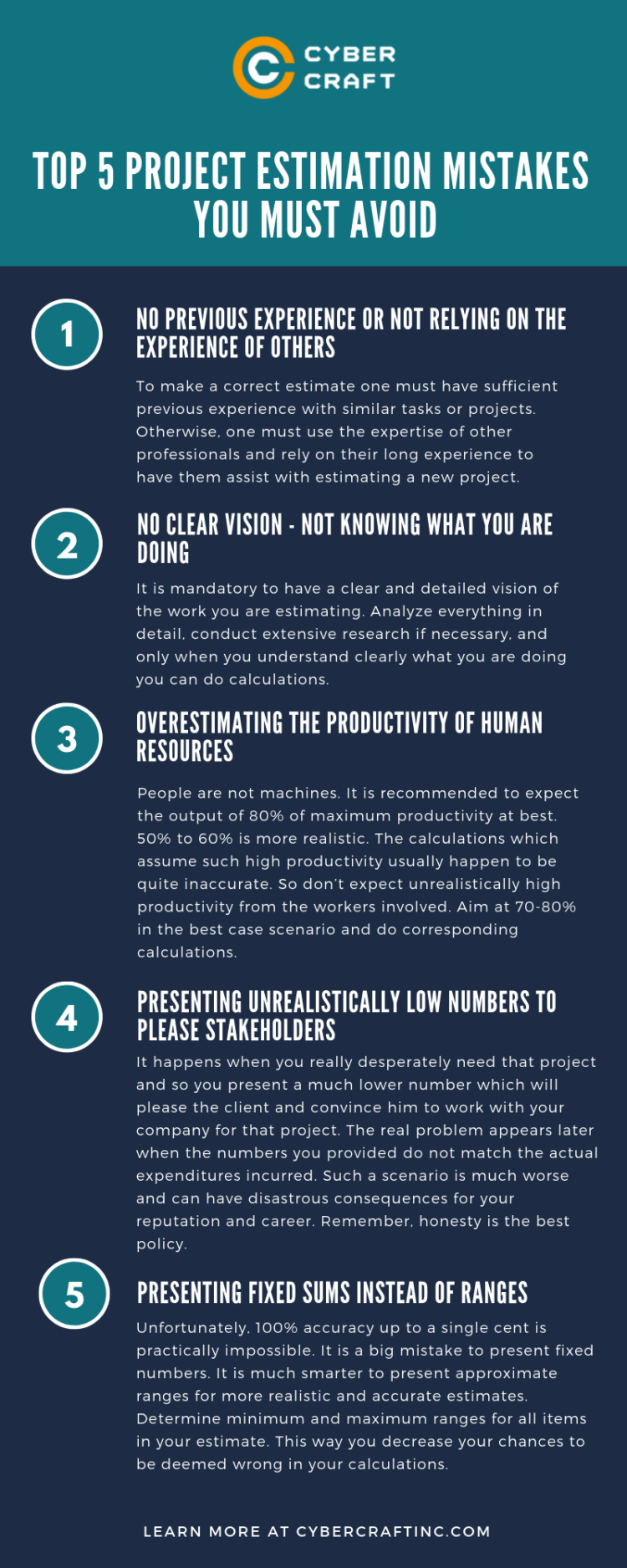
No Previous Experience or Not Relying on the Experience of Others
To make a correct estimate one must have sufficient previous experience with similar tasks or projects. Otherwise, one must use the expertise of other professionals and rely on their long experience to have them assist with estimating a new project. If you are not experienced with the types of tasks you are currently estimating and have no sufficient expertise in that area then don’t try to do all calculations yourself.
Ask someone experienced to help you and provide his or her analysis. Otherwise, your calculations may prove totally inaccurate. It often happens that you don’t have the time or ability to find experienced professionals. In such a case, it may be a good idea to rely on companies with a proven track record such as CyberCraft and outsource all hard work to experienced managers.
No Clear Vision – Not Knowing What You Are Doing
As we have already said, it is mandatory to have a clear and detailed vision of the work you are estimating. Oftentimes, managers begin calculations without fully understanding the scope and nature of a project and its peculiarities. They don’t have a clear vision of what should get done, how, why, when and by whom. As a result, they do incorrect calculations.
Therefore, the very first thing you must do is to analyze everything in detail, conduct extensive research if necessary, and only when you understand clearly what you are doing you can do calculations.
Overestimating the Productivity of Human Resources
Some managers naively believe that all human resources always work at 100% of maximum productivity. Even worse, they do estimations based on this assumption. People are not machines. It is recommended to expect the output of 80% of maximum productivity at best. 50% to 60% is more realistic.
The calculations which assume such high productivity usually happen to be quite inaccurate. So don’t expect unrealistically high productivity from the workers involved. Aim at 70-80% in the best case scenario and do corresponding calculations.
Presenting Unrealistically Low Numbers to Please Stakeholders
This is a grave error which is very frequent. It may occur due to incentive-caused bias. It happens when you really desperately need that project and so you present a much lower number which will please the client and convince him to work with your company for that project. Another example would be when you don’t present realistic numbers to your boss because you’re afraid that he won’t approve that project you’ve been dreaming to work on for so long.
In all those cases, we deal with managers presenting incorrect numbers to decision makers/important stakeholders in order to please them. The real problem appears later when the numbers you provided do not match the actual expenditures incurred. Such a scenario is much worse and can have disastrous consequences for your reputation and career. Remember, honesty is the best policy.
Presenting Fixed Sums Instead of Ranges
Unfortunately, 100% accuracy up to a single cent is practically impossible. Therefore, it is a big mistake to present fixed numbers. It is much smarter to present approximate ranges for more realistic and accurate estimates. Determine minimum and maximum ranges for all items in your estimate. This way you decrease your chances to be deemed wrong in your calculations.
Besides practical advice and useful techniques, many people are looking for helpful tools and software for estimating which is what we will cover next.
The Best Tools for Successful Project Estimation
Doing estimates is much easier when you use the right tools. Here are some which are definitely worth trying:
- Smartsheet – A multifunctional platform for work management and automation. Includes tools for expenditure management and estimation.
- CMAP Software – A great tool for estimating.
- Simplestimate – Free SaaS tool for cost estimating.
- BrainLeaf – A great scoping tool perfectly suitable for estimating costs.
- Eastimate – A free web-based app for estimating.
- Wrike – A complete project management software solution. Cost management and estimate functions are included.
- Price&Cost – A great SaaS tool for cost management and estimations. Provides extensive functionality for projects of all scopes, even the most complex ones.
- Microsoft Excel – All-time classic. The most popular and simplest tool for doing estimates.
- Google Spreadsheets – Similar to Excel but with more functionality and being web-based.
If you are wondering which of all these are our favorites, don’t be surprised if we say Google Sheets. Project cost management and estimating are not complicated. Neither do they have to be. All calculations can be done with a simple tool like Google Sheets. It is just that managers often tend to overcomplicate things.
Final Words
We hope this guide has given you a clear understanding of what project estimation is and how to do it correctly. Using one of the estimation methodologies and applying all the principles presented you will undoubtedly manage to do correct estimates for all your projects in your future work. Remember, accuracy is the only thing that matters in estimations. We will end with the words of Richard Feynman, a Nobel prize physicist, who once said: “The first principle is that you must not fool yourself and you are the easiest person to fool…”




